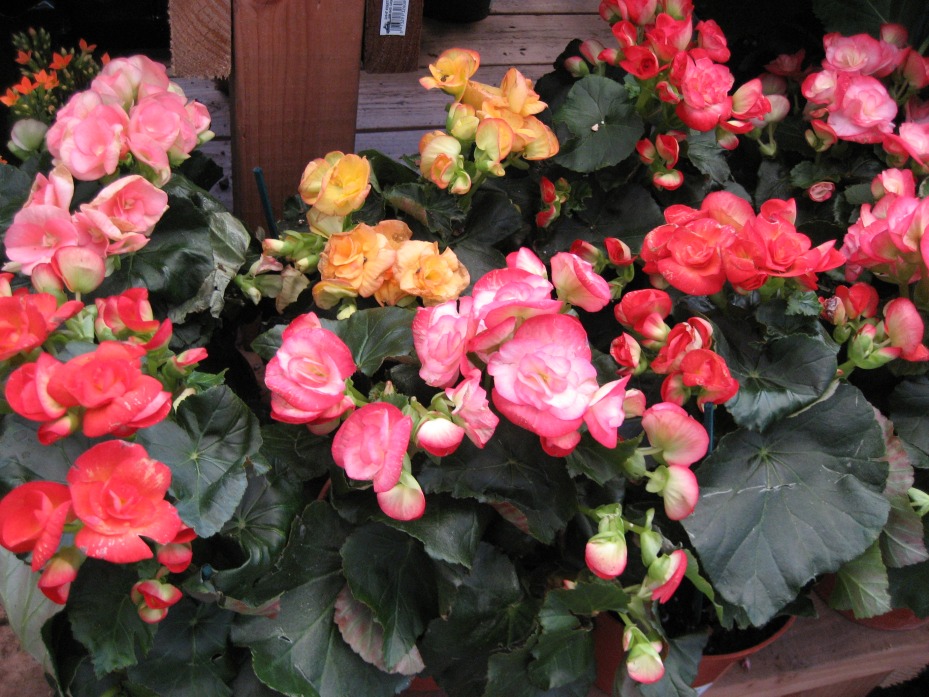- Begonia
image_width = 250px
image_caption = "Begonia cultivars"
regnum =Plant ae
divisio = Magnoliophyta
classis =Magnoliopsida
ordo =Cucurbitales
familia =Begoniaceae
genus = "Begonia"
genus_authority = L.
subdivision_ranks = Species
subdivision = Selected species:
* "Begonia auriculata " Hook.
* "Begonia fusicarpa " Irmsch.
* "Begonia macrocarpa " Warb.
* "Begonia mannii " Hook.f.
* "Begonia oxyloba " Welw. ex Hook.f.Begonia is a
genus in theflowering plant familyBegoniaceae . The only other member of the family Begoniaceae is "Hillebrandia ", a genus with a single species in theHawaiian Islands . The genus "Symbegonia" is now included in "Begonia". "Begonia" is the common name as well as the generic name for all members of the genus.With fraction 1500+ species, "Begonia" is one of the ten largest
angiosperm genera. The species are terrestrial (sometimesepiphytic )herb s or undershrubs and occur in subtropical and tropical moist climates, in South andCentral America ,Africa and southernAsia . Terrestrial species in the wild are commonly upright-stemmed,rhizomatous , ortuberous . The plants aremonoecious , with unisexual male and female flowers occurring separately on the same plant, the male containing numerousstamen s, the female having a large inferior ovary and two to four branched or twisted stigmas. In most species thefruit is a winged capsule containing numerous minute seeds, althoughbaccate fruits are also known. The leaves, which are often large and variously marked or variegated, are usually asymmetric (unequal-sided).Because of their sometimes showy flowers of white, pink, scarlet or yellow color and often attractively marked leaves, many species and innumerable hybrids and
cultivar s are cultivated. The genus is unusual in that species throughout the genus, even those coming from different continents, can frequently be hybridized with each other, and this has led to an enormous number of cultivars. The American Begonia Society classifies begonias into several major groups: cane-like, shrub-like, tuberous, rhizomatous, semperflorens, rex, trailing-scandent, or thick-stemmed. For the most part these groups do not correspond to any formal taxonomic groupings or phylogeny and many species and hybrids have characteristics of more than one group, or fit well into none of them.The genus name coined by
Charles Plumier French patron ofbotany honors Michel Bégon, a former governor of the french colony ofHaiti .Cultivation
The different groups of begonias have different cultural requirements but most species come from tropical regions and therefore they and their hybrids require warm temperatures. Most are forest understory plants and require bright shade; few will tolerate full sun, especially in warmer climates. In general, begonias require a well-drained growing medium that is neither constantly wet nor allowed to dry out completely. Many begonias will grow and flower year-round but tuberous begonias usually have a dormant period, during which the tubers can be stored in a cool and dry place.
Begonias of the semperflorens group are frequently grown as bedding plants outdoors. A recent group of hybrids derived from this group is marketed as "Dragonwing Begonias"; they are much larger both in leaf and in flower. Tuberous begonias are frequently used as container plants. Although most "Begonia" species are tropical or subtropical in origin, the Chinese species "B. grandis" is hardy to USDA
hardiness zone 6 and is commonly known as the "hardy begonia". Most begonias can be grown outdoors year-round in subtropical or tropical climates, but in temperate climates begonias are grown outdoors as annuals, or as house or greenhouse plants.Most begonias are easily propagated by division or from stem cuttings. In addition, many can be propagated from leaf cuttings or even sections of leaves, particularly the members of the rhizomatous and rex groups.
The cultivar
Kimjongilia is a floral emblem ofNorth Korea .Gallery
References and external links
*1911
* [http://www.begonias.org American Begonia Society]
* [http://www.bioone.org/bioone/?request=get-abstract&issn=0363-6445&volume=028&issue=04&page=0693 Phylogenetic Relationships of the Afro-Malagasy Members of the Large Genus "Begonia" Inferred from trnL Intron Sequences]
* [http://www.ingentaconnect.com/content/aspt/sb/2005/00000030/00000003/art00017 A Phylogeny of "Begonia" Using Nuclear Ribosomal Sequence Data and Morphological Characters]
* [http://www.springerlink.com/(vylxjw45gax3bqakqnuvoy45)/app/home/contribution.asp?referrer=parent&backto=issue,5,12;journal,29,1501;linkingpublicationresults,1:104878,1 A recircumscription of Begonia based on nuclear ribosomal sequences]
Wikimedia Foundation. 2010.

